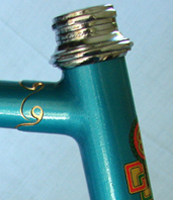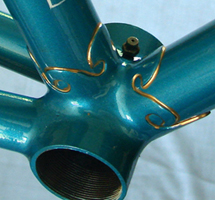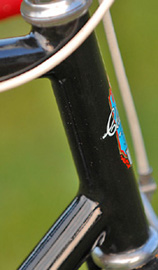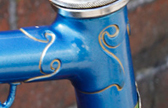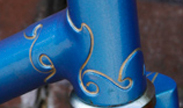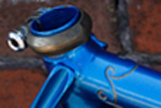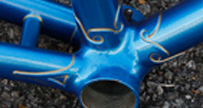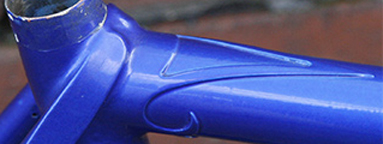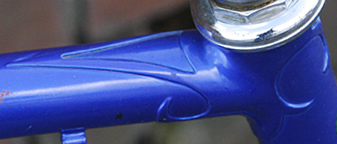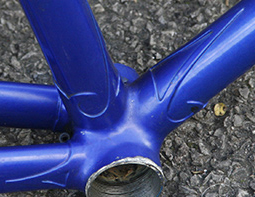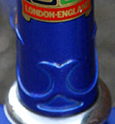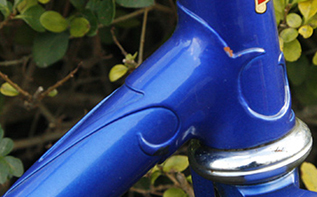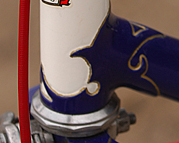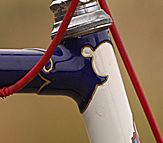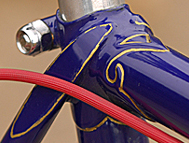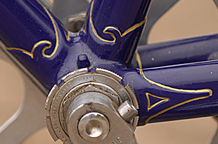Butler, Claud - Bi-laminated Frames
Posted: Monday 08th June 2020
Claud Butler himself, never a man to understate the case when it came to promoting his own products, had this to say about bi-laminated frames:
The bi-laminated frame is ‘The greatest advance in frame building technique since the evolution of the safety bicycle. 25 per cent stronger than the ordinary brazed joint, as proved by official NPL (National Physical Laboratory) tensile test. Enables me to build your frame to any desired angles (if practical) without lug pulling. Proved sound by practical demonstration on the roads and tracks of the World, including all post-war World’s Championships and Olympic Games series. THIS IS THE TYPE OF FRAME CONSTRUCTION WHICH I RECOMMEND.’
Thus the CB brochure for 1951 gushes praise for the bi-laminated principle of frame construction. It may be over-stating the case when he describes it as the greatest advance in frame building technique since the evolution of the safety bicycle, but there is little doubt that the end result is a frame joint that is stronger and with less flex than either a plain fillet-brazed joint or a brazed lug joint.
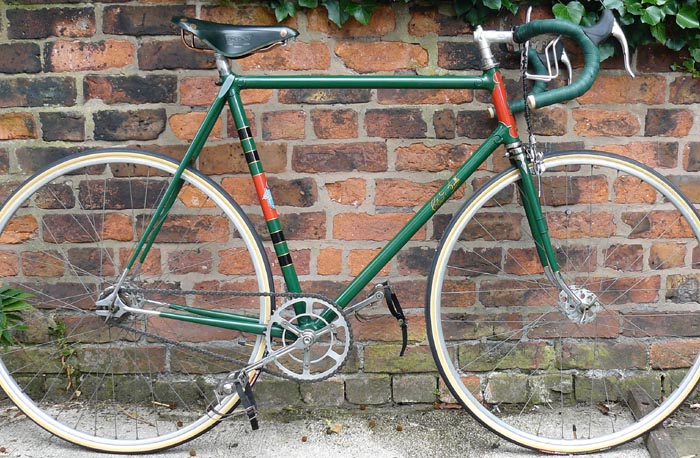
What does Bi-laminated mean?
It is basically a system whereby a frame is constructed using reinforcing sleeves that are brazed to the ends of each of the tubes. The tubes are then mitred and sif-bronze welded (fillet brazed) to create the frame. The resultant structure benefits from a reinforced joint area. The sleeves are shaped not only to give a decorative appearance in the manner of conventional lugs but also to remove any sudden change in section which would produce stress raisers.
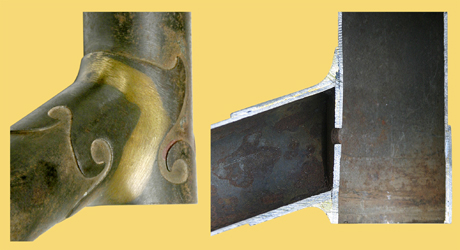
The Advantages
In addition to the obvious structural advantages of having more material at the area around each joint, this type of construction allows any angles and any size frame tubes to by used, within reason. Oversize top tubes were often selected to further improve resistance to twist or ‘whip’. So, in practice, does it result in a superior frame? In my experience of riding a 1955 Avant Coureur Spécial, the answer is yes. It is notably steady with reassuringly consistent steering, yet it is also lively and retains a resilient ride. In terms of stability it bears comparison with a Cantiflex-tubed Bates or the more modern Colnago Master, both of which feature specially profiled frame tubes to produce a stiffer frame.
This is what Cycling Weekly’s Nimrod had to say after an extensive three-month trial of an early pre-production Avant Coureur in 1947:
‘I would have no hesitation in recommending it to the mass start rider, the time triallist or any other lightweight connoisseur. The liveliness of the machine and the steadiness of the steering at all times and on even the worst road surfaces was remarkable, and to back up the manufacturer’s confident assertion that ‘whip’ is eliminated completely, I can say that never at any time did I feel the slightest sign of this unpleasant tendency.’
The bi-laminated principle does indeed deliver the goods.
Partial-bi-lam Axe Head
This is probably the first of the CB bi-lams that was labelled as such and it is a variation of the classic CB Axe Head lug design. It consists of axe head design sleeves or bi-laminations over the three main frame tubes only. The bi-lams are absent from the head tube itself. This was used in 1947 for a pre-production Avant Coureur tested by Nimrod in Cycling and described in the October 8th edition as ‘introducing a new method of frame construction, the CB patented ‘Bi-laminated’ process.’
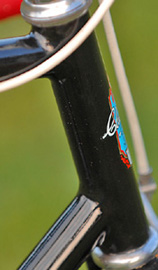
Before the Bi-lam.
The bi-laminated frame principle was a development of the bronze-welded frame, now commonly known as fillet-brazed. It seems that the technique of joining lightweight frame tubes by creating a fillet of braze around the tube joints using SIF-bronze welding became well established in France by the mid 1930s. At this time, the organisers of the Tour de France race stipulated that all competitors had to use the same type of bicycle. The chosen design was bronze welded, a relatively new process for very thin-walled cycle frame tubing.
Left: The CB Jubilee frame is bronze welded, a technique used since the 1930s. Bi-laminating was a development of that process.
The T de F machines would have been displayed at the Paris cycle show and it is certain that the likes of Claud Butler, Sandy Holdsworth and Harry Rensch would have taken an interest when they visited the show. Sure enough, these makers began experimenting with ‘welded’ frames shortly afterwards and these were in production pre-WW2. The bronze-welded frame really came to prominence soon after the war, when lug sets were sometimes in limited supply due to the steel shortages. Adding bi-laminates to enhance the integrity of the joint was a natural development of the fillet-brazed frame.
It is interesting to note that today’s fillet-brazed frames are generally more expensive than lugged frames because it is a highly skilled process and skilled labour is not cheap. Immediately after the war, however, there was no shortage of skilled labour and labour was cheap, so fillet-brazed frames were generally less expensive than their lugged equivalents.
The pictures clearly show the pre-poduction Avant Coureur frame with these partial bi-lams, but whether these were also used on the first production machines is not known. Despite the 1947 Cycling feature, the Avant Coureur model was absent from the 1948 brochure so it is not known whether it had the partial bi-lams on its introduction that year. What we do know is that for the 1949 model year it had the full axe head bi-lams which are described as an ‘improved version of the CB Bi-laminated’ principle. The partial bi-lams, however, were a feature of the 1949 Sport Anglais model and also for the Deluxe Tourer of that year.
It has been reported that a CB frame with partial bi-laminated construction was made as early as 1940, although it is probable that any such frames were one-offs or prototypes as there is no mention of this type of construction in sales brochures of the period. It would seem that the partial bi-lam design was not used after about 1950.
Axe Head
The axe head design dates way back to the late 1930s with the Anglo Continental model, although this was a lugged frame. The same attractive and distinctive design was introduced using the bi-laminated principle on the Avant Coureur model from the 1948 model year (it is thought) until 1951, when frames with this design became known as the New Allrounder. Meanwhile, the top of the range Avant Coureur model became the Avant Coureur Spécial for 1951, with entirely different long spearpoint bi-lams (see below). The Axe Head design continued with the New Allrounder frame until the closure of the Clapham works in October 1956. The Axe Head bi-lams were also a feature of the Olympic Path model of 1949.
De Luxe Long Spearpoint
This type of bi-lam was used initially for certain CB path or track models from about 1950, presumably because it resulted in particularly strong joints. The design was also taken up for the new Avant Coureur Spécial. Long spearpoint bi-lams were used for the following models:
| 1951 | Championnat d'Olympique (track) |
| 1951-52 | Avant Coureur Spécial |
| 1951-55 | Olympic Sprint (track) |
Short Spearpoint
This was a feature of the following models:
| 1953 | A/C 53 |
| 1954-55 | Avant Coureur Spécial |
| 1955-6 | Avant Coureur |
A striking feature of the new for 1953 de-luxe short spearpoint bi-laminations is the resemblence to the very much in-vogue Nervex Professional lugset. However, it is only in the head tube profile where this resemblence exists.
POPULAR CLAUD BUTLER MODELS FEATURING BI-LAMINATED FRAMES
Identifying the different frame models can be somewhat daunting because CB had a tendency to use different names for the same bi-lam design. Therefore, It helps to know the year of manufacture. Fortunately, all bi-laminated frames produced in the 1950s have the year and month of manufacture stamped on the bottom bracket alongside the serial number. For example, the number 549 was a frame produced in September 1954. If a CB bi-lam frame has no date marking, then it must be pre-1950. No bi-laminated frames were produced after the Clapham works closed in late 1956, when the production of ‘real’ Claud Butler frames and cycles ceased. Here is some additional information on the most popular bi-lam models:
The Avant Coureur, A/C 53 and Avant Coureur Spécial
The Avant Coureur was a top of the range model and was produced with Reynolds 531 (or Kromo) butted tubing throughout and with 74/72 angles. Of course, any angles could be specified to special order, and it was not uncommon for the larger frame sizes to be produced with an oversized (1 1/8in) top tube to add further rigidity. The Avant Coureur models featured a special sleeved seat cluster with integral clamp and semi-wrapover seat stays. However, the other bi-laminated (and fillet brazed) models usually lacked the reinforcement at the seat tube and therefore required a separate seatpin clip. But there are exceptions. Certainly some New Allrounders were produced with the Avant Coureur style seat cluster, although whether this was due to supply shortages, special customer orders, or variations for a certain model year is not known.
The Avant Coureur was produced from late 1947 to late 1950 with Axe Head bi-lams
For the 1952 model year it had ‘De Luxe’ Long Spearpoint bi-lams and it was called the Avant Coureur Spécial
For the 1953 model year the bi-lams were changed to Short Spearpoint type. This was called the A/C 53 for 1953 only.
The name reverted to Avant Coureur Spécial from 1954. However, the final catalogue CB produced in November 1955 lists this same model as the Avant Coureur – the ‘Spécial’ was dropped once again.
No wonder there is confusion in defining this model.
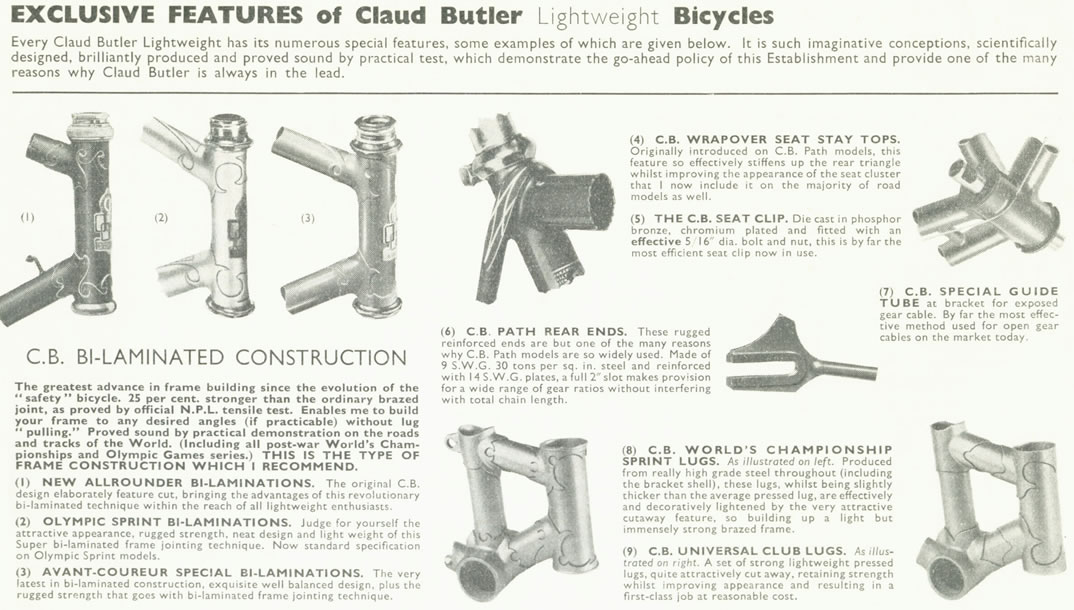
New Allrounder
Axe Head bilams were used from the New Allrounder’s introduction for the 1951 model year up until the end of CB production in 1956. Angles were usually 73 head, 71 seat, and the tubing was butted Reynolds 531 or A & P Kromo. Although this model used identical bi-lams to the Avant Coureur, it generally employs a separate seat clip rather than the Avant Coureur’s integral clamp and bi-lamination at the top of the seat tube, but there are exceptions. Most of the New Allrounder models that I have come across feature concave topeyes rather than the semi-wrapover type of the Avant Coureur, but again there was some variation in the style of seatstay topeye over the five year production span.
Olympic Sprint
This track model shares the same long spearpoint bi-lam design as the early Avant Coureur Spécial and also has the reinforced seat cluster. It also features a 1 1/8in top tube. It was a little heavier than the World Championship Sprint model, which used brazed lug construction. Interestingly, the bi-lam Olympic Sprint was initially less expensive than the lugged model, but by 1955 it was actually more expensive and was the second most expensive frame listed for 1955. Angles were usually 73 parallel or 75/72, the seatstays were wrapover style and the tubing was of course 531 or Kromo. Frames were close clearance and featured round-section fork blades. The Olympic Sprint was available from 1951-56.
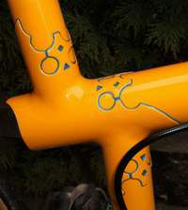
Other makers using bi-laminations
Left: Paris bi-laminated lug on their Galibier model with large diameter down tube
As a final point, it should be noted that Claud Butler was by no means the only producer of bi-laminated frames and it is far from certain whether he was actually the first to do so. Harry Rensch’s Paris concern was particularly well known for its bi-lam frames, while Gillott was another skilled practitioner with a bilam option for its top-of-the-range Fleur de Lis model. Other frame makers also produced bi-lam frames.
Note: The above material was sourced from original CB sales brochures and from contemporary reports in the cycling press, along with personal observation of frames with known date of manufacture. Bear in mind that information printed in sales brochures or in the press is not always correct in every detail. In particular, the specification of a frame may change between the date a sales brochure was produced and the date the frame actually reached production, or indeed during the production span. When a model year is quoted above, this would usually start from the annual cycle show of the preceding year, usually held in November. A 1952 catalogue model, for example, might have been on sale from November 1951, or perhaps even earlier.
It is certain that there are frames in existence which do not conform in some way or other to the catalogue description, either due to shortages of certain parts at the factory or because of a customer’s specific requirements. Therefore, the information above must be considered as a guide only rather than a definitive article. If any reader can supply additional information regarding bi-laminated CB frames, this would be welcomed and can be added to this page.
Webmaster: Bilaminated or Bi-laminated? As Claud Butler used the hyphen we have decided to do the same for this article.
For more on Claud Butler visit www.nkilgariff.com/ClaudButler.htm
Posted: Monday 08th June 2020
Contents
- The bi-laminated frame
- The bi-laminated frame image
- Bi-laminated
- The bi-lam
- Advantages
- Before the Bi-lam
- Frames
- Avant Coureur frame
- CB frame
- Axe Head
- Axe head images
- De Luxe Long Spearpoint
- Long spearpoint bi-lams models
- Spearpoint bi-lams
- Short Spearpoint
- Spearpoint models
- Short spearpoint bi-lams
- Popular models
- Claud Butler catalogue
- New Allrounder
- Other makers using bi-lamination
Chapters
This article appears in the following categories.
Upcoming Events
Whether you are looking for a gentle social meet up, or a 100-mile ride browse the community’s upcoming events and plan your next weekend outing.

